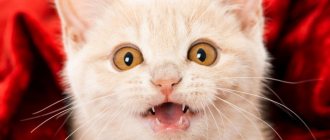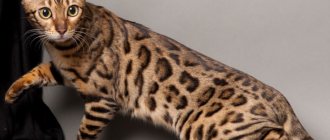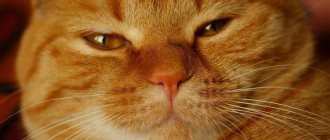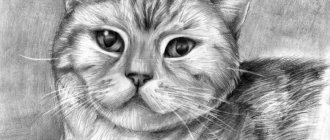Wild cat and its features
The animal weighs from 3 to 8 kg, and its height reaches 50 cm. The muzzle has a flattened shape. The ears are set wide and rounded. The tail is short, but thick and very fluffy.
The coat of a wild cat is gray-brown or yellowish with dark stripes. At the same time, the fur on the abdomen is colored ocher. There are often white spots under the neck, and black rings on the tail. Cats shed twice a year.
Unlike domestic cats, forest cats hardly meow. Only sometimes they make sounds reminiscent of a hoarse “meow”. Mostly they growl, hiss and even whistle.
In total, there are 23 species of wild forest cats in nature, but the most common are five:
- reed , which is also called the swamp lynx for its large ear tufts and red color;
- leopard print , which has gray spots on a red coat;
- Amur with a pronounced ocher color with red or brown spots;
- European , gray with dark stripes, the largest of all representatives of the breed;
- Caucasian , which has a brownish color with spots all over the body.
Wild forest cats, found in mountainous areas, are distinguished by a warmer coat with a thick undercoat and long hair. Animals living in the desert are small in height and weight. Cats live on average from 10 to 15 years; domesticated ones can live 30 years.
Reproduction
Females reach sexual maturity in the first year of life, and males only after 3 years. The mating season for wild cats begins in the spring and continues until summer. Fierce battles between rivals are accompanied by fights and menacing sounds. The winner mates with the female.
The female's pregnancy lasts 2 months, during which time she prepares her rookery for future offspring. In abandoned burrows, in hollow trees or in the empty trunk, she lines her lair with grass and feathers.
There can be a different number of kittens in a litter, usually from 3 to 7. Upon birth, the cubs develop quickly, after 5–7 days the eyes open and after a month the forest kitten is already crawling out of the shelter. Up to 4 months, the female feeds the kittens with her milk. At the age of 6 months, wild cat kittens leave the care of their mother and begin an independent lifestyle.
How did the forest cat appear?
Researchers from the United States have revealed that the wild forest cat is the great-great-grandfather of modern cats, which were domesticated more than 10,000 years ago. This happened in the Middle East, where there were grain storage facilities, which created nests for rodents near them. Following the rodents, hunters appeared - cats.
Wild cats gradually got used to human habitation and became domesticated, but some animals remained living in the wild, although the population was sharply declining.
Habitat and character
Animals live in Central and Western Europe, the Caucasus and Central Asia. They settle in forest thickets, rocks, and mountains. Their shelters can be the nests of large wading birds, burrows of small animals, such as badgers, and hollows of old trees.
The animals are very shy and practically do not approach human habitation. Wild cats are loners. Each representative has his own territory, which he is ready to defend.
The wild forest cat is a predatory animal that hunts at night. He goes out for prey before sunset or before dawn. When he tracks down the prey, he rushes at it, covering a distance of three meters, and kills the victim. If the jump is unsuccessful, the animal leaves the potential prey alone.
Food for wild forest cats includes water rats, mice, and hamsters. Ferrets and weasels also become their prey. But here it’s not easy for cats, since these animals themselves are predators and are ready to fight back against the felines.
Their favorite treat is squirrels. To get to the delicacy, forest cats are ready to climb the tallest trees.
Sometimes cats hunt wild ducks and some other waterfowl, and also catch fish and crayfish. They can destroy nests and eat eggs and chicks.
dalnevostochnyy_leopard_rgo-dalnevostochnyy-leopard-foto_valeriy_maleev.jpg
Far Eastern leopard. Photo: Valery Maleev
Interesting Facts
- The leopard feeds mainly on ungulates, as well as raccoon dogs, badgers, and hares. The leopard does not attack livestock, but can hunt dogs.
- Typical habitats for the Far Eastern leopard are coniferous-deciduous forests of the Manchurian type. The predator prefers territories with rugged terrain, steep slopes of hills, rocky outcrops and watersheds.
- The length of males reaches 136 cm. The weight of a male reaches 60 kg.
- Each leopard has its own unique spotted pattern, thanks to which scientists distinguish these predators.
- The Far Eastern leopard is the most peaceful subspecies of leopard. Throughout history, not a single case of an Far Eastern leopard attacking a person has been recorded. Out of curiosity, young individuals can follow the tracks of a person - if they meet by chance, they do not rush to run away, but study the person with interest, without showing signs of aggression.
Choosing a kitten
A wild forest cat can become a pet, but it will not abandon its wild habits. Kittens are not cheap, but almost all of them are in good health. Wild cats, like domestic cats, also become attached to their owners, but often show their wild character.
Wild cats are suitable for those people who spend most of their time at work and are rarely at home. Forest cats require minimal care. The main thing is to prepare the necessary food for them, which can be done, for example, on weekends.
You should only get a wild kitten if you have your own area where the animal can roam freely
Other signs about white cats
People have accumulated a lot of superstitions associated with white cats. In the old days, they were even credited with the ability to foretell approaching love. According to the superstition, a girl who has no luck in finding her betrothed just needs to give 7 white male kittens into good hands, and her soulmate will certainly appear soon. Guys who can't find a bride should do the same, only with female kittens.
According to another sign, in order to get rid of loneliness and find a life partner, an unmarried woman should get a white cat, and an unmarried man should get a cat of the same color. The appearance of a pet will awaken new feelings in a lonely person, a desire to take care not only of himself, but also of those around him. This will be a turning point in life, the bachelor will feel more confident and will soon find a soul mate.
If you meet a white cat on the road, it is advisable to feed it, especially if it is homeless. In gratitude for the food, the animal will take away all troubles and sorrows, and higher powers will reward the person.
If your profession involves constant risk to life or health, then you need a white cat in the house. Signs say that it will fill your home with positive energy and will be a talisman against misfortunes.
The animal will become a reliable protector of the home. To enhance the effect of the sign, knowledgeable people recommend performing the following ritual. Every time you leave your home, before closing the front door, whisper to the cat with the following phrase: “Sleep, guard the house and don’t bully the brownie.”
Traditional healers advise people with vision problems to regularly stroke the tail of a white cat. At first glance, the advice seems ridiculous. But scientists have proven that touching the warm fluffy fur of an animal relieves nervous tension. This has a beneficial effect on the entire body, including the eyes. The recommendation to pet a cat, and even in a specific place, is aimed at suggestible people. Detailed instructions are needed to convince a person of the effectiveness of the method.
Life in captivity: care features
Wild forest cats live in zoos and nature reserves. If you keep a pet in captivity, then, first of all, you need to take into account that it prefers a large territory. It is better to build an enclosure for him, placing logs there, on which the cat will climb just like in the wild. At the same time, remember that wild cats are very conservative animals and really do not like change. If something is changed and rearranged in his possessions, he will not like it very much.
Caring for it will not require much time. It is enough to brush six times a week and bathe once a month.
Balanced soft and dry food intended for domestic cats is of no use to wild animals. His diet will have to include lean meat: veal, turkey, beef. Give your pet raw sea fish, but without small bones. The cat will happily eat boiled eggs and fermented milk products. But be sure to add vitamin and mineral complexes to your food, as pets need calcium and phosphorus.
Wild life
Something striped threw its striped tail aside and looked at us with attentive eyes, as if it understood that we were talking about a cat. I was trying to compare, does it look like a domestic cat or not? Looks like it!
Meanwhile, the cat disappeared. But my friends gave me a very good photo as a gift. A photograph of a large wild cat is now in front of you. It is a large and skilled hunter with good hearing, sight and smell. A hunter who is well aware of his strength, agility, independence and even courage. My friends called the forester, who knows the life of a cat in the forest well, and he willingly told about his observations.
In the Western part of Europe, wild cats live in forests without visible problems, choosing places where the forest is not too cultivated and they can hide in it. Cats live on the ground, but are very good at climbing trees if they are in danger. But they have no obvious enemies. They only protect kittens from martens. They themselves hunt mainly for mice, young hares and birds nesting on the ground. Solitary life is characteristic of savages. But in March they are going to “weddings”. Cats fight with the enemy, filling the forest with characteristic screams. Domestic cats sometimes come to these spring games, and cats are where the “tiger stripes” come from in the offspring of domestic cats.
In Eastern Europe, wild cats do not live in forests. But it happens that a cat is drawn into the forest and it begins to live in the wild. What happens with this?
A forester who lived near Lgov, Kursk region, told me: “The first snowfall falls, and they are right there, gathering at the cordon. Eight to ten pieces. They climb into the attic, climb into the hayloft, and hide in the canopy. One day one fell through the pipe straight into the pan.”
They get rid of extra cats in villages simply: they put them in a bag, take them into the forest and release them there: if you can do it, live. Country cats are no match for city cats, the cooped up sissies. The village cat catches mice, sparrows (and sometimes chickens, for which, by the way, he ends up in a bag). Once in the forest, she will not die of hunger and very soon she will even appreciate the benefits of wild life. There are a lot of mice in the forest. And besides, bird nests and the birds themselves. But winter comes - and Maslenitsa ends for the cat: cold, hungry. Cats are running from all sides to the forest hut...
Forest wild cat.
But here's an amazing case: the cat endured the winter in the forest, and not a mild winter and a snowy one. In the Oksky Nature Reserve, when counting animals based on their tracks, they noticed strange imprints in the snow. They wondered: who could it be? Nobody even thought it was a cat.
She was seen in the flood. In spring, the forests near the Oka River flood over vast areas. And only the “mountains” remain dry. Small unflooded islands of land are called mountains here. Some help to save hares, raccoons, and foxes. On others, black grouse are showing. Timoshkina Griva is just such an island. The ornithologists of the reserve had set up a hut on the “mountain” ahead of time and really hoped to observe the lekking from it. But for some reason the black grouse did not land on the island. Something was interfering with the grouse weddings. They began to look around the island and found a cat. She waited out the flood here, hunting for mice and, perhaps, birds.
In the morning we agreed to visit the island. In the sea, the waters saw it when they swam close - a strip of land with last year's yellow grass and a straw hut. All around in the water are willows, oaks and lindens. Black grouse flew up from the trees. And where is the one who prevents them from living on earth? We looked around the island, looked at the hut. No one. We walked on dry land two more times—miracles in a sieve! — the cat disappeared somewhere. Shrugging our shoulders, we were already heading towards the boat, when suddenly, near the water itself, under an inclined bush of coarse grass, I saw the tip of a tail. He trembled a little.
Realizing that she had been discovered, the cat darted across the land like a bullet, rushed into the water, swam and looked out from the tree with yellow, evil eyes. It was a fluffy, dark gray animal, completely wild in the forest. I have seen various other animals on the islands during high water. The presence of a person, of course, frightened them, but they usually behaved much calmer. There's a little tiger right there. If he had the strength to do so, he would rush to defend his island.
While looking for a spot to shoot, I wandered into the water. But the cat decided that she was surrounded, jumped from the tree, swam to the bushes, but, realizing that it would be difficult for her to stay on them, swam back to the island and hid in the hut.
Cats don't like water. But, as we see, they swim well. Feral cat behavior is not rare. It is rare to be able to survive a harsh winter in the forest... We looked for feathers on the island and did not find them. Apparently, mice served the domestic savage as food in the winter and now, during the floods.
A cat overwintered in the forest.
A rare case, but not the only one. Hunter and scientist Leri Aleksandrovich Kazakov sent me a good book from the Murmansk region. While reading a book, I saw these lines on some page: “We ended up in one of the abandoned villages when people left it. We hoped we would find shelter and spend the night. We saw dogs barking at a large pine tree near the road. We noticed something dark on the pine tree. They decided it was a squirrel. They fired one shot. And suddenly something falls to the ground from above with a loud cry: “Meow! Meow!" Cat! Two summer seasons and a whole winter have already passed since people left here. They abandoned or simply forgot their home friend, who managed to survive in this wilderness. Judging by the meeting place, the cat obtained food for itself in the nearby forest, having fully adapted to the wild way of life.”
And one more observation. For twenty-five years I went to the Old Believers Lykovs. He asked how they lived, what they remembered, how they met people, what they asked for? The eldest Agafya said: “They asked people for salt. And in order for them to bring us cats, the mice won over.” I knew: the geologists brought the cats. And they had kittens. And the cat immediately disappeared into the taiga. Appeared when snow fell. The cat didn’t like the food—boiled potatoes. In the spring he ran away again. It was noticed that the cat was catching mice and small birds. He came to the hut only to visit the cats. He became wild and hid from people. He came up to me, smelling sausage in my backpack. I respected the eater's appetite, and the cat followed me on my heels.
A year later, Agafya said: “Before winter, he showed up with a torn side. I don’t know who offended him. The cat liked his free life, but he disappeared. Maybe the bear grabbed my fish traps? I don’t know... Free life in the taiga is dangerous..."
Taking care of your health
Wild animals are distinguished by enviable health, but are susceptible to some kidney and heart diseases that are characteristic of the breed. They also have retinal dysplasia. Therefore, they need to get the necessary vaccinations and visit a veterinarian once every six months.
Under no circumstances should an animal be castrated. Anesthesia does not affect him badly and the consequences can be disastrous.
Animal mating
Forest purrs mate no more than once or twice a year. At the same time, they are similar to the “song” of domestic cats. Females reach sexual maturity at 9-10 months and can have offspring. Cats “grow up” until they are 2 years old. Only at this age are they ready to conceive offspring. During the mating season, males gather in groups and often fight over the female. The winner begins mating with the female.
Before the birth of the cubs, the cat sets up her home, making sure that the kittens are warm and dry. Males practically do not take part in raising offspring, but sometimes they bring prey to the female’s den.
Typically, a wild cat litter contains 3-6 kittens. They feed on their mother's milk for up to six weeks, but then begin to learn how to hunt. At three months, they already obtain food for themselves on a par with adults.
So are there ginger cats?
You can never predict how the genetic code of an individual will be formed and which genes will become dominant. Thus, the idea that there are no red cats is a myth. The truth is that completely red females are actually rarer. The ratio of orange seals to females of the same color is approximately 1:4.
Much more often you come across female cats with a mixed color, including white and black pigment. But pure orange ones, as a rule, are rare.











